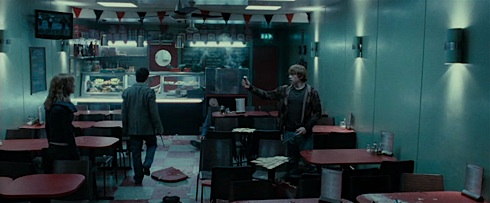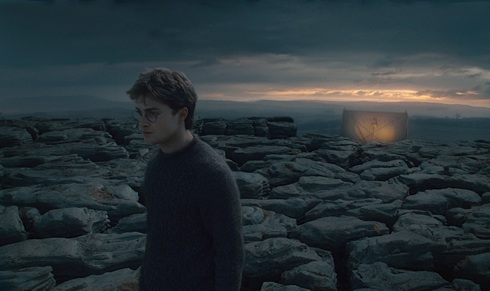And so the Harry Potter film rewatch comes to a close. It’s been quite an experience, with a couple large-ish surprises: one, I had remembered Goblet of Fire kind of fondly as a movie, only to discover to that was actually godawful (I probably would have failed a field sobriety test when I saw it in theaters, to be fair), and two, the David Yates movies—Order of the Phoenix onward—really are remarkably tight pieces of mainstream studio filmmaking.
Deathly Hallows Part 1 picks up right where Half-Blood Prince left off in terms of economical adaptations that take advantage of what cinema has to offer storytelling rather than simply photocopying the book. I reviewed it upon its release last November, which means less time has passed since the first viewing than it has with any of the other movies in the series. Despite that relatively short passage of time, it still was, necessarily, a different experience.
The first viewing of Deathly Hallows Part 1 left me extremely impatient to get on with the rest of the story. The decision to break Deathly Hallows up into two movies annoyed me at first, it seeming a bit of a money grab on the part of Warner Bros, but gradually I came around to the silver-lining perspective that two movies meant less had to be cut from the book, which I adored. That being said, the first time I saw it I was simultaneously impressed by how well it was directed, sardonically amused by the fact that we had to be introduced to Bill Weasley and Mundungus Fletcher for the first time due to cuts in the previous movies, and only disappointed really that it had to end.
Rewatching it, I was struck by just how skillful David Yates’ direction really is. It would have been nice if it hadn’t taken until the sixth movie for the series to find its cinematic voice, but the fact that it eventually did deserves recognition. The fact that Yates hitting his stride leads to there being a car chase—a car chase! Oh loving, generous gods—in a Harry Potter movie, and such a nicely shot and cut one at that, makes me very happy. After all, if Hagrid is going to be driving Harry around in Sirius Black’s old flying motorcycle… it doesn’t just have to fly, you know? Using it as a motorcycle is perfectly acceptable.
Another scene toward the beginning of the picture that jumped out is the scene when, after the Death Eaters break up Bill and Fleur’s wedding and Hermione zaps the trio to a London cafe, the two Death Eaters show up and start a ruckus, and how said ruckus feels like a gun fight. All too often, in previous Potter movies, scenes of wizard dueling were too reliant on actors squaring off, holding their wands out, and making determined, constipated faces while dumb-looking CG electricity crackled all over the place. The cutting was a little sluggish, I imagine because the producers were saying “we spent so much on these special effects, let’s get our money’s worth,” and this led to inert action scenes. This cafe shootout is deliberately shot and cut as if the Death Eaters and our heroes are firing guns at each other, and it has the same visceral impact.

Because of what happens in the part of the book that Deathly Hallows Part 1 covers, there’s necessarily a bit of a slow stretch where the action is pretty much Harry, Hermione, and (for part of the time) Ron wandering around the English countryside wondering where to start looking for Horcruxes. If anything, this sequence benefits from being trimmed a bit in the movie, as Rowling handled it nicely in the book, but Ron was grumpy for longer and I’ve personally never been particularly fond of a grumpy Ron.
Ron’s (temporary) departure from the cohort leads to a scene that I found rather sweet the first time I saw it, and actually kind of brilliant the second time around: the part where Harry puts some music on the wizard radio to cheer Hermione up and then gets her to dance in an attempt to cheer her up. Since the first movie—which went into production somewhere around the time Goblet of Fire hit bookstores—the movies have been dying to pair off Harry and Hermione romantically. It’s ancient movie wisdom: the main hero and the main heroine are the ones who get together. It has ever been thus. It didn’t matter that the whole Yule Ball fiasco in Goblet of Fire might as well have been in a chapter entitled “Ron & Hermione Like Each Other And Are Eventually Going To Become A Couple But He’s Too Immature To Realize It Yet,” the movies were deadset on nudging Harry and Hermione together. The dance scene, coming as it does in the first part of the last movie, functions as kind of a tribute to this amusingly thwarted plot, as well as being an expression of Harry wanting to cheer his friend up. Fittingly for both motivations, it doesn’t work.
The movie itself does, though. While a number of lovely bits from the book were cut for length, their absence resonated less the second time, because while I’ve maintained this in less elegant form for some time, this rewatch has led to me to totally embrace and apply to the Potter movies what Sir Ian McKellen once said about Lord of the Rings: “the book is the book and the film is the film.” Compromises must be made with regards to one’s favorite parts of any book when adapting it into a movie, all the more so when they’re as packed with detail as the Potter books. Personally, I’ll accept things like losing Kreacher going from mean old Death Eater-sympathizing ghoul to lovable old breakfast-making curmudgeon (and don’t get me wrong, I loved that) just as long as the movies don’t have stuff like Harry and Hermione dating.
On the whole, given Part 1‘s success as a piece of filmmaking, I’m looking forward to Part 2. The acting, as always (another surprising realization in this rewatch), is first rate, with Dan Radcliffe having progressed from competent to legitimately impressive over the course of the series, and Rupert Grint and Emma Watson progressing from erratic to solid. The grownups haven’t much to do in this installment, with so much of the movie given over to the kids wandering around on the Horcrux hunt, with series newcomer Rhys Ifans a bit normal as Xenophilius Lovegood, and Ralph Fiennes a more Ralph Fiennes-y Voldemort than he had been before. Helena Bonham Carter puts in another solidly insane turn as the loathsome Bellatrix Lestrange. But, of course, there’s always Part 2 for the old folks (and, not a spoiler to anyone who’s read the book, but man am I looking forward to seeing Helena Bonham Carter playing Hermione playing Bellatrix, that promises to be great fun).
The rewatch ends here, but Part 2 remains. Fittingly, I’ll end on a bit of a cliffhanger, though not as dramatic a one as Voldemort finding the Elder Wand (which worked really well the second time around). For the thrilling, edge-of-your-seat conclusion, stay tuned for the review of Deathly Hallows Part 2!
Danny Bowes is a playwright, filmmaker and blogger. He is also a contributor to nytheatre.com and Premiere.com.










